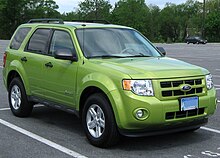Hybrid vehicle
A hybrid vehicle is a vehicle that uses two or more distinct power sources to move the vehicle. The term most commonly refers to hybrid electric vehicles (HEVs), which combine an internal combustion engine and one or more electric motors.
Power
Power sources for hybrid vehicles include:
· Coal, wood or other solid combustibles
· Human powered e.g. pedaling or rowing
· Hydrogen
· Petrol or Diesel fuel
· Solar
· Wind
· Waste heat from internal combustion engine.
Engine type
When the term hybrid vehicle is used, it most often refers to a Hybrid electric vehicle. These encompass such vehicles as the AHS2 (Chevrolet Tahoe, GMC Yukon, Chevrolet Silverado, Cadillac Escalade, and the Saturn Vue), Toyota Prius, Toyota Camry Hybrid, Ford Escape Hybrid, Toyota Highlander Hybrid, Honda Insight, Honda Civic Hybrid Lexus RX 400h and 450h and others. A petroleum-electric hybrid most commonly uses internal combustion engines (generally gasoline or Diesel engines, powered by a variety of fuels) and electric batteries to power the vehicle. There are many types of petroleum-electric hybrid drivetrains, from Full hybrid to Mild hybrid, which offer varying advantages and disadvantages.
Continuously outboard recharged electric vehicle (COREV)
Given suitable infrastructure, permissions and vehicles, BEVs can be recharged while the user drives. The BEV establishes contact with an electrified rail, plate or overhead wires on the highway via an attached conducting wheel or other similar mechanism. The BEV's batteries are recharged by this process—on the highway—and can then be used normally on other roads until the battery is discharged.
This provides the advantage, in principle, of virtually unrestricted highway range as long as you stay where you have BEV infrastructure access. Since many destinations are within 100 km of a major highway, this may reduce the need for expensive battery systems. Unfortunately private use of the existing electrical system is nearly universally prohibited
Hybrid fuel (dual mode)
In addition to vehicles that use two or more different devices for propulsion, some also consider vehicles that use distinct energy sources or input types ("fuels") using the same engine to be hybrids, although to avoid confusion with hybrids as described above and to use correctly the terms.
Fluid power hybrid
Hydraulic and pneumatic hybrid vehicles use an engine to charge a pressure accumulator to drive the wheels via hydraulic or pneumatic (i.e. compressed air) drive units. The energy recovery rate is higher and therefore the system is more efficient than battery charged hybrids, demonstrating a 60% to 70% increase in energy economy in EPA testing. Under tests done by the EPA, a hydraulic hybrid Ford Expedition returned 32 miles per US gallon (7.4 L/100 km; 38 mpg-imp) City, and 22 miles per US gallon (11 L/100 km; 26 mpg-imp) highway. UPS currently has two trucks in service with this technology.
While the system has faster and more efficient charge/discharge cycling and is cheaper than gas-electric hybrids, the accumulator size dictates total energy storage capacity and requires more space than a battery.
Environmental impact of hybrid car battery

Though hybrid cars consume less petroleum than conventional cars, there is still an issue regarding the environmental damage of the hybrid car battery. Today most hybrid car batteries are one of two types: (1) nickel metal hydride, or (2) lithium ion; both are regarded as more environmentally friendly than lead-based batteries which constitute the bulk of gasoline car starter batteries today. There are many types of batteries. Some are far more toxic than others. Lithium ion is the least toxic of the three mentioned above.
The toxicity levels and environmental impact of nickel metal hydride batteries—the type currently used in hybrids—are much lower than batteries like lead acid or nickel cadmium.
However, nickel-based batteries are known carcinogens, and have been shown to cause a variety of teratogenic effects.
REALICE LAS ACTIVIDADES INGRESANDO A LOS COMENTARIOS

REALICE LAS ACTIVIDADES POR ESCRITO Y LLEVELAS A CLASE CUANDO LA PROFESORA SE LAS PIDA:
ResponderEliminarA- Diga si las afirmaciones son verdaderas o falsas:
1. El auto híbrido combina dos tipos de motores.
2. Un recurso energético de este auto es el aire comprimido.
3. Estos autos usan sólo nafta.
4. Estos autos se recargan sólo cuando está parado.
5. La recarga de la batería necesita una infraestructura apropiada.
B) COMPLETAR LAS ORACIONES EN ESPAÑOL:
1.In addition to vehicles that use...
2. Hydraulic and pneumatic hybrid vehicles use...
3. While the system has faster ...
4. Though hybrid cars consume ...
5. Today most hybrid car batteries are ...
6. The Lithium-ion battery has attracted ...
7. The lithium-ion batteries are appealing ...
8. Additionally, use ...